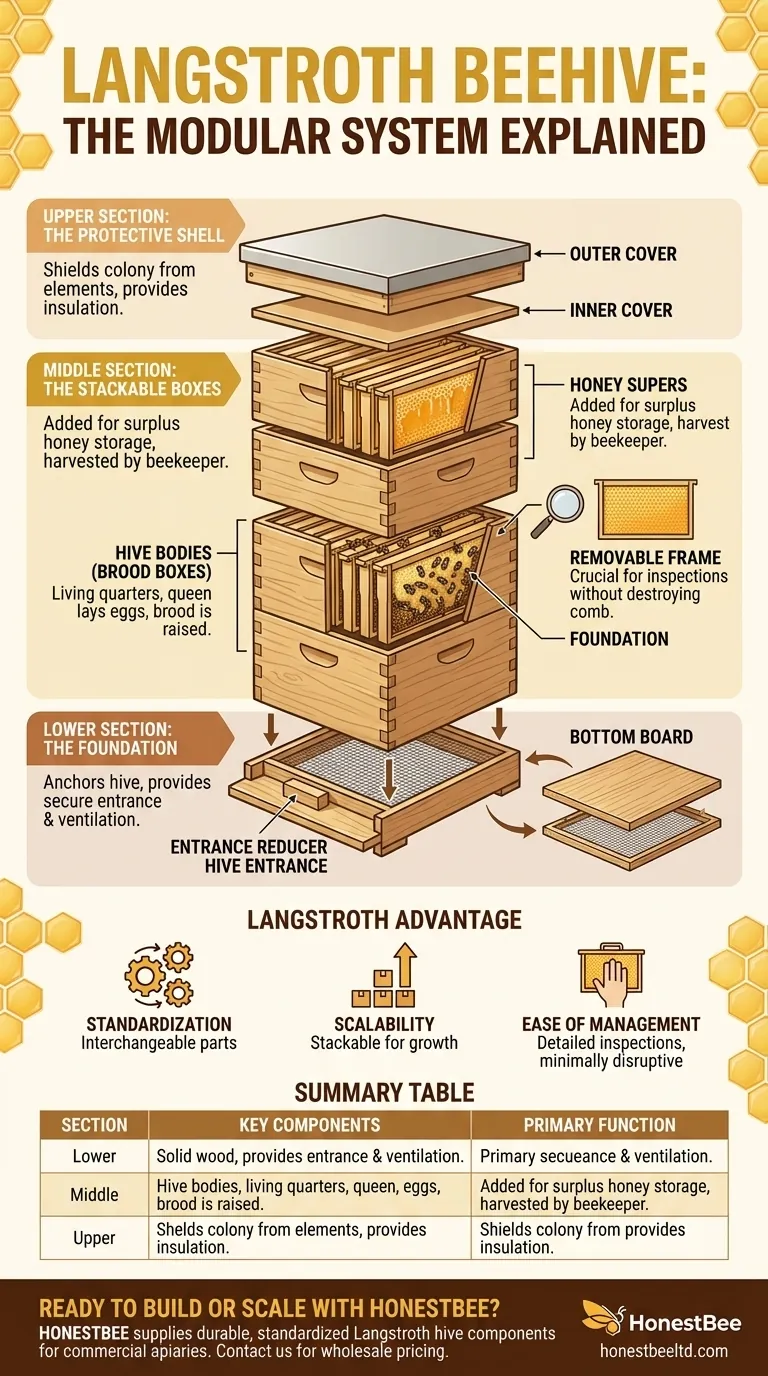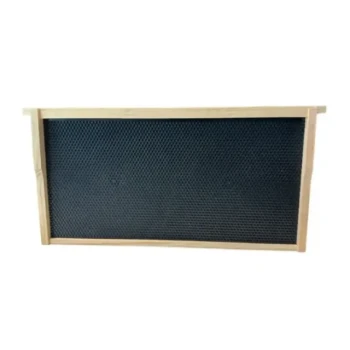At its core, a Langstroth beehive is a modular system composed of three primary sections. These are the lower section, which serves as the foundation and entrance; the middle section, consisting of stackable boxes that house the colony and its resources; and the upper section, which acts as the protective roof.
The Langstroth hive's revolutionary design lies not just in its parts, but in its modularity. Each component works together to create an expandable home for bees that can be managed and inspected by a beekeeper without destroying the colony's comb.

The Foundation: The Lower Section
The lower section anchors the hive to the ground and provides the bees with a secure entrance and exit. It is the starting point for the entire structure.
The Bottom Board
The bottom board is the floor of the beehive. It can be a solid piece of wood or a screened bottom, which provides better ventilation and helps in monitoring for pests like varroa mites.
The Entrance
The bottom board features an opening that serves as the hive entrance. Beekeepers often use an entrance reducer—a small block of wood with different-sized notches—to control the size of this opening, helping the colony defend itself and regulate temperature.
The Heart of the Hive: The Stackable Boxes
This middle section is the living quarters of the colony. It's designed to expand vertically as the colony grows in population and gathers more resources.
Hive Bodies (Brood Boxes)
The first boxes placed on the bottom board are the hive bodies, often called brood boxes. These are typically deep boxes where the queen lays her eggs and the colony raises its young bees (the brood).
Honey Supers
As the colony expands and needs more storage space, the beekeeper adds shallower boxes called honey supers on top of the brood boxes. This is where the bees will store surplus honey, and it is from these supers that a beekeeper harvests.
The Removable Frames
Inside every box are removable frames. This is the single most important innovation of the Langstroth design. Each frame holds a sheet of honeycomb, allowing the beekeeper to lift out and inspect individual sections of the hive without destroying the comb, which is crucial for monitoring the colony's health.
Foundation
Frames are often fitted with foundation, which is a sheet of plastic or beeswax imprinted with a hexagonal pattern. This provides a guide for the bees to build straight, uniform honeycomb, making the frames easier to manage.
The Protective Shell: The Upper Section
The upper section serves as the roof of the hive, shielding the colony from rain, sun, and other environmental factors.
The Inner Cover
The inner cover is a flat board that sits directly on top of the uppermost box. It provides an insulating dead air space and prevents the bees from gluing the outer cover down with propolis, making hive inspections much easier.
The Outer Cover
The outer cover is the hive's roof. The most common type is a telescoping cover, which has sides that fit down over the top of the hive, providing superior protection from the elements.
Understanding the Langstroth Advantage
The design's widespread adoption is not accidental. Its components and modularity provide distinct advantages for both bees and beekeepers.
Standardization and Interchangeability
The Langstroth hive is the industry standard. Most parts are built to uniform dimensions, meaning components from different manufacturers are often interchangeable, making it easy to find and replace equipment.
Scalability for the Colony
The ability to stack boxes means the hive can grow or shrink with the colony's needs. A beekeeper can add supers during a strong nectar flow or combine weaker colonies into a single stack of boxes.
Ease of Management
The system of removable frames revolutionized beekeeping. It allows for detailed inspections, disease management, and honey harvesting in a way that is minimally disruptive to the bees.
Applying This to Your Hive
Understanding these sections helps you assemble a hive and manage it according to your goals.
- If your primary focus is starting a colony: You will need one complete set of the three sections—a bottom board, at least one deep brood box with frames, an inner cover, and an outer cover.
- If your primary focus is honey production: Your key task will be adding and managing honey supers in the middle section during the nectar flow.
- If your primary focus is colony health: The removable frames inside the boxes are your most important tool, allowing you to inspect the brood pattern and check for signs of disease.
This modular system provides a logical, manageable, and highly effective way to work with and support a healthy honeybee colony.
Summary Table:
| Section | Key Components | Primary Function |
|---|---|---|
| Lower Section | Bottom Board, Entrance Reducer | Foundation, Hive Entrance, Ventilation |
| Middle Section | Brood Boxes, Honey Supers, Frames | Colony Living Quarters, Brood Rearing, Honey Storage |
| Upper Section | Inner Cover, Outer Cover | Insulation, Protection from Elements |
Ready to build or scale your apiary with the right equipment?
HONESTBEE supplies durable, standardized Langstroth hive components to commercial apiaries and beekeeping equipment distributors through our wholesale-focused operations. Our equipment supports the scalable, manageable system that keeps colonies healthy and productive.
Contact HONESTBEE today for wholesale pricing on hive bodies, supers, frames, and more. Let us help you equip your operation for success.
Visual Guide

Related Products
- Long Langstroth Style Horizontal Top Bar Hive for Wholesale
- Professional Hive Top Bee Feeder for Beekeeping
- Professional In-Hive Bee Feeder HONESTBEE Frame for Beekeeping
- JZBZ Langstroth Queen Rearing Frame for Beekeeping
- Wholesales Dadant Size Wooden Bee Hives for Beekeeping
People Also Ask
- What are the benefits of a top bar hive? A Natural, Low-Impact Approach to Beekeeping
- How are entrances designed in top bar hives? Master Beehive Layout for Maximum Honey
- What is a top bar bee hive? A Natural, Low-Stress Beekeeping Solution
- How does the top bar hive help control varroa mites? A Natural Approach to Mite Management
- What are the main differences between Langstroth hives and top bar hives? Choose the Right Hive for Your Beekeeping Goals



















